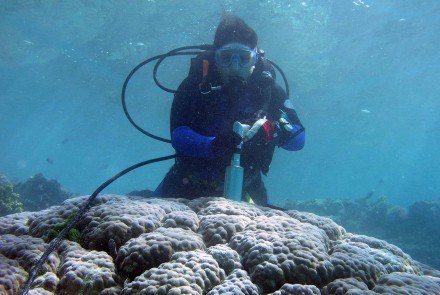Coral skeletons tell historical tale of water pollution

Fertilizer applied to crops doesn’t necessarily stay on land. The skeletons of coral on the Great Barrier Reef are the proof.
Recent research by Dr Jennie Mallela, from the Research School of Earth Sciences and the Jennions Lab at the Research School of Biology, shows that the levels of phosphorous in coral located close to shore have increased over recent decades. This increase is related to the increased discharge of phosphorous coming from adjacent land.
Phosphorous, a chemical element that is present in fertilizers, has been linked with deteriorating water quality and can have detrimental impacts on coral reefs including reduced growth and in some instances, death of entire coral colonies.
“One of the things that has been highly controversial about the Great Barrier Reef is the causes of deteriorating of water quality, and the associated deterioration of coral reefs, but there is a lack of water quality information,” explains Dr Mallela.
“There are water quality programs that run for 5-10 years, but we are missing long term data that encompass decades of information.
“I wanted to see is if we could get that information using coral skeletons. The great thing about corals is that they are a bit like trees in the sense that they have annual growth bands and we can date them easily. They are also very long-lived.”
Dr Mallela studied massive Porites coral, a long-lived coral family that is very abundant across the Great Barrier Reef. She specifically looked at Porites found off Dunk Island, a near shore reef in the central Great Barrier Reef.
“One of the great things about ANU is that there are brilliant geochemical analytic tools that allow us to look at what the coral skeleton actually captures,” says Dr Mallela.
“My colleagues and I were also able to tie in data we were getting from the coral skeleton with data from the land, which is actually quite rare.
“Steve Lewis, a co-author on this research, and colleagues, were able to get river quality records and annual records of fertiliser-phosphorous application for our study region all the way back from 1925 to 2005.”
Dr Mallela stresses the fact that we need to be aware that what we do on land really does affect water quality.
“Nothing is isolated,” she says.
“What we do on land does affect water quality in rivers, and it also has impacts on the marine environment. And these impacts have a lag effect – they can happen down the line. The impacts can vary depending on the season, what kind of weather is happening, whether there is rain, and so on.”
The good news is that there is the potential to manage the amount of phosphorous entering the water.
“Whether people are putting too much fertilizer on their land in general, or whether they are putting it on during periods of rain which then washes it into the water can be investigated. We can then help with the management of fertilizer application and whether they are using too much,” says Dr Mallela.
Dr Mallela’s research, Coral Skeletons Provide Historical Evidence of Phosphorus Runoff on the Great Barrier Reef was published in PLOS ONE.
Photo: Dr Jennie Mallela taking a coral core skeleton sample.
